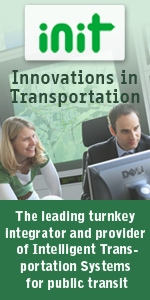

| In This Issue |
| » NEWS HEADLINES |
| » COVERAGE OF THE 2010 APTA RAIL CONFERENCE |
| » COMMENTARY |
| » PEOPLE ON THE MOVE |

The classifieds in this issue offer employment at transit and government agencies throughout North America!
| COMMENTARY |
'Livability’: Wimpy Term but Means Big Stakes for Us All
BY NEAL PEIRCE
WASHINGTON—Is the Obama administration’s “livability” initiative just a way for intrusive federal bureaucrats to choke off Americans’ prized “automobility”—four wheels to commute from ever-distant suburbs or just to pick up a quart of milk?
This is the way some commentators would have it. Disregarding the administration’s clear language about respecting local character and values, they pounced on words of Transportation Secretary Ray LaHood—that livability is “being able to take your kids to school, go to work, see a doctor, drop by the grocery or post office, go out to dinner and a movie, and play with your kids in a park, all without having to get in your car.”
LaHood, a former Republican member of Congress known for his moderate views, got labeled the "secretary of behavior modification” by columnist George F. Will. Sen. Kit Bond, R-Mo., worried publicly about “federal decision-makers in Washington ... (telling) communities how they should grow.”
And transportation analyst Ken Orski recently concluded that “the administration’s desire to impose its own vision of how Americans should live and travel represents a misguided and in the end futile gesture.”
Whoa!
There’s no question the word “livability” is wimpish and terribly imprecise (if anyone has a better synonym, please speak up). Yet the intent is as American as apple pie.
“Livability is a shorthand way of saying we’re going to spend $1 to solve $4 worth of challenges," says District of Columbia planning director Harriet Tregoning. "It’s about getting multiple outcomes that communities want with a single investment. It’s an approach any conservative should love.”
Examples: As combined housing and transportation costs begin to eat up as much as 60 percent of working families’ incomes, livability means encouraging energy-efficient housing at locations close to work sites with public transit options, enhancing Americans’ real incomes.
As the nation’s prospective future oil supplies dwindle in the face of BP-Gulf-type disasters, plus price escalation and/or cutoffs by hostile foreign regimes, livability means tilting government’s regulatory and incentive tools toward more compact, close-in, less petroleum-demanding communities—undergirding national security in the process.
As health costs from escalating obesity threaten a tsunami of diabetes, heart, and cancer conditions undermining Americans’ life expectancy, reducing personal incomes, and ravaging government budgets, a planning “tilt” encouraging less sedentary time in cars and more exercise and walking makes huge sense. That’s “livability” too.
As America’s existing infrastructure of roads, waterworks and sewage facilities crumbles, running up a cumulative bill in the trillions, the idea of “fix it first” of existing systems, of restoring older communities, should easily trump public funds going to finance infrastructure for disconnected enclaves of new family homes, apartments, and strip malls.
But what about those Americans who prefer living in suburban communities they consider safe, with the privacy of their own backyards and, in Orski's words, “the freedom, comfort, convenience and flexibility of personal transportation”? Isn’t this what most Americans would consider livability?
The answer is surely “yes” for millions. And it’s likely the suburbia they know and love (pending a cataclysmic energy crisis) will endure for decades to come.
But past needn’t be prelude. The “American century” of cheap energy and road-heavy development costs is over. And we can see the first wave of change in high numbers of today’s most creative American professionals (and youth) opting for the excitement of city life or seeking out more walkable suburban town centers.
As 100 million more Americans join us by 2040 (according to Census projections), we need far more creative, money-saving, energy-conscious, walkable, multiservice communities.
Can—or should—the federal government mandate that all local governments make those choices? No. But it can encourage them, rejigger funding and planning incentives for saner choices, publicize new models, and hold competitions for best new practices.
In fact, a clear-headed national government owes us no less. Because its job is to protect the national security, set strict environmental safety rules, and encourage our competitiveness on the world economic stage.
If you like weak and ineffectual governance from Washington, just apply the operating rules of the Minerals Management Service that failed to avert the truly appalling Gulf of Mexico crisis, or the financial regulators who failed to protect us against the excesses that triggered the Great Recession.
A federal finger on the scale in favor of compact, economical, resource-conserving development doesn’t need to be as heavy as safety regulation. Key words in the administration’s initiative are affordability, access, choices, connection, character of place, collaboration—hardly some kind of ruthless dictation. But we do need federal leadership—no apologies—in the tradition of the bold nation-building initiatives of our history, from the canals and first railways to today’s interstate system.
And if this means a reprise of the more compact “know your neighbor” town and city patterns that served America so well up to World War II, we’ll be well served.
Contact Neal Peirce here.
© 2010, The Washington Post Writers Group
| « Previous Article | Return to Top | Return to Main | Next Article » |
|
||||||
| AMERICAN PUBLIC TRANSPORTATION ASSOCIATION |
Telephone (202) 496-4800 • Fax (202) 496-4321
Search Back Issues
